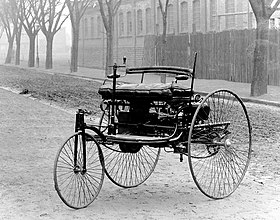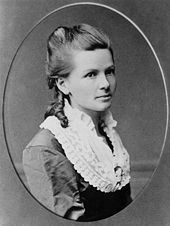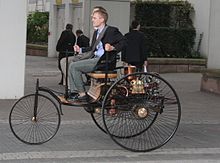auto.wikisort.org - Automobile
The Benz Patent-Motorwagen ("patent motorcar"), built in 1885 by the German Carl Benz, is widely regarded as the world's first practical modern automobile[1][lower-alpha 1] and was the first car put into series production.[8] It was patented and unveiled in 1886. The original cost of the vehicle in 1886 was 600 imperial German marks,[9] approximately 150 US dollars (equivalent to $4,524 in 2021).
This article needs additional citations for verification. (July 2011) |
| Benz Patent-Motorwagen | |
|---|---|
 Benz Patent-Motorwagen Nr. 1 | |
| Overview | |
| Manufacturer | Rheinische Gasmotorenfabrik Benz & Cie. (known today as Mercedes-Benz) |
| Production | 1886–1893 |
| Powertrain | |
| Engine | 1.0L (954cc) single cylinder engine 2⁄3hp (Ligroin) |
| Chronology | |
| Successor | Benz Velo |
Karl's wife Bertha demonstrated its feasibility in a trip from Mannheim to Pforzheim in August 1888, shortly before it became the first commercially available automobile in history in the late summer of 1888.[10]
Due to the creation of the Patent-Motorwagen, Benz has been hailed as the father and inventor of the automobile.[1][11][12]
Development and specifications
After developing a successful gasoline-powered two-stroke piston engine in 1873, Benz focused on developing a motorized vehicle while maintaining a career as a designer and manufacturer of stationary engines and their associated parts.

The Benz Patent-Motorwagen was a motor tricycle with a rear-mounted engine. The vehicle contained many new inventions. It was constructed of steel tubing with woodwork panels. The steel-spoked wheels and solid rubber tires were Benz's own design. Steering was by way of a toothed rack that pivoted the unsprung front wheel. Fully elliptic springs were used at the back along with a beam axle and chain drive on both sides. A simple belt system served as a single-speed transmission, varying torque between an open disc and drive disc.
The first Motorwagen used the Benz 954 cc (58.2 cu in) single-cylinder four-stroke engine with trembler coil ignition.[13] This new engine produced 500 watts (2⁄3 hp) at 250 rpm in the Patent-Motorwagen, although later tests by the University of Mannheim showed it to be capable of 670 W (0.9 hp) at 400 rpm. It was an extremely light engine for the time, weighing about 100 kg (220 lb). Although its open crankcase and drip oiling system would be alien to a modern mechanic, its use of a pushrod-operated poppet valve for exhaust would be quite familiar. A large horizontal flywheel stabilized the single-cylinder engine's power output. An evaporative carburettor was controlled by a sleeve valve to regulate power and engine speed. The first model of the Motorwagen had not been built with a carburettor, rather a basin of fuel soaked fibers that supplied fuel to the cylinder by evaporation.
The vehicle was awarded the German patent number 37435, for which Karl Benz applied on 29 January 1886. Following official procedures, the date of the application became the patent date for the invention once the patent was granted, which occurred in November of that year. Benz unveiled his invention to the public on 3 July 1886, on the Ringstrasse in Mannheim.
Benz later made more models of the Motorwagen: model number 2 had 1.1 kW (1.5 hp) engine, and model number 3 had 1.5 kW (2 hp) engine, allowing the vehicle to reach a maximum speed of approximately 16 km/h (10 mph). The chassis was improved in 1887 with the introduction of wooden-spoke wheels, a fuel tank, and a manual leather shoe brake on the rear wheels.
About 25 Patent-Motorwagen were built between 1886 and 1893.


Bertha Benz's trip
Bertha Benz, Karl's wife, whose dowry financed the development of the Patent-Motorwagen,[14] was aware of the need for publicity. She took the Patent-Motorwagen No. 3 and drove it on the first long-distance internal combustion automobile road trip to demonstrate its feasibility. That trip occurred in early August 1888, when she took her sons Eugen and Richard, fifteen and fourteen years old, respectively, on a ride from Mannheim through Heidelberg, and Wiesloch, to her maternal hometown of Pforzheim.[15]

In Germany, a parade of antique automobiles celebrates this historic trip of Bertha Benz every two years. On February 25, 2008, the Bertha Benz Memorial Route,[16] following the route of Benz's journey, was officially approved as a Tourist or Scenic Route by the German authorities as a route of industrial heritage of mankind. The 194 km (121 mi) of signposted route leads from Mannheim via Heidelberg to Pforzheim (Black Forest) and back.
In media

The car can be driven in the video game Gran Turismo 4 and Android video game Driving Legends: The Car Story. It was also driven by Sherlock Holmes's sister Enola in the film Enola Holmes.
See also
- History of the automobile
- Benz Velo (later 4 wheel model)
- List of Mercedes-Benz vehicles (incl. summary of Benz vehicles)
- List of motorcycles of the 1890s
- List of motorized trikes
- Three-wheeler
Early developments essential to the development of automobiles
- Nicolas Léonard Sadi Carnot, physics of the internal combustion engine
- Illuminating gas, first internal combustion engine fuel
- Ligroin or heavy naphtha, first liquid automotive fuel, n-hexane
Car and car engine designers, chronologically by first vehicle/engine built
- Nicolas-Joseph Cugnot (1725–1804), French inventor of the world's first automobile, a 1769–1770 steam-fuelled vehicle
- Étienne Lenoir, developer of the first atmospheric gaseous fueled internal combustion engine and automobile (1860–1863), pioneer of electroplating
- Nicolaus Otto, developer of the first successful compressed charge gaseous fueled internal combustion engine (1860s–70s)
- Siegfried Marcus, developed petrol-powered, internal combustion engine vehicles (1864? 1870? 1888)
- Wilhelm Maybach, designed engines starting in the 1870s–80s; first motorbike (1885), second internal combustion car (1889)
- Gottlieb Daimler, German engineer, pioneer of internal-combustion engines and automobile development (1870s and on)
Notes
- Before Carl Benz patented his Motorwagen in 1886, several inventors were working on automobiles powered by steam engines; in 1769, Nicolas-Joseph Cugnot built the first steam-propelled vehicle.[2] During the 1870s, Bollée created several steam vehicles which could carry passengers for road trips.[3] Steam cars have, however, been characterized by various authors as "distinctly uncommercial",[1] "unsafe",[4] and "difficult to manage".[5] According to automotive historian G. N. Georgano, earlier steam vehicle experiments and innovations such as the stationary Otto engine helped make the invention of the Benz Motorwagen possible, which he labelled as "the first motorcar" due to its commercial production.[6] The company Mercedes-Benz also acknowledge there were forerunners to the Motorwagen, but also state that Benz was the first to develop "a "horseless carriage" into a product for everyday use, which he then brought to market and as a result made his idea useful for the entire world".[7]
References
- Parissien, Steven (2014). The life of the automobile : the complete history of the motor car. Internet Archive. New York, N.Y. : Thomas Dunne Books, St. Martin's Press. pp. 2–5. ISBN 978-1-250-04063-3.
- "Nicolas-Joseph Cugnot". Encyclopædia Britannica. Retrieved 22 October 2022.
- Lavergne, Gérard (1902). The Automobile: Its Construction and Management. Cassell. p. 17.
- Frey, Carl Benedikt (2020). The Technology Trap: Capital, Labor, and Power in the Age of Automation. Princeton University Press. p. 166. ISBN 9780691210797.
- Bailey, Diane (2015). How the Automobile Changed History. ABDO. p. 28. ISBN 9781629697666.
- Georgano, G. N. (1985). Cars, 1886–1930. Beekman House. pp. 9, 16. ISBN 9780517480731.
- "Forerunners to the automobile". Mercedes-Benz Group. Retrieved 22 October 2022.
- "Der Streit um den "Geburtstag" des modernen Automobils" [The fight over the birth of the modern automobile] (in German). German Patent and Trade Mark Office. 2014-12-22. Archived from the original on 2017-01-02.
- Neil, Dan (2006-06-21). "Before the Rumble Seat". Los Angeles Times. Retrieved 2020-05-02.
- "Carl Benz and the Invention of the Automobile". 29 January 2018.
- von Fersen, Olaf (2013). Ein Jahrhundert Automobiltechnik: Personenwagen (in German). Springer-Verlag. p. 10. ISBN 9783642957727.
- Derry, Thomas Kingston; Williams, Trevor Illtyd (1960). A Short History of Technology from the Earliest Times to A.D. 1900. Courier Corporation. p. 393. ISBN 9780486274720.
- "The birth of the automobile". Daimler AG. Archived from the original on 21 November 2015. Retrieved 1 October 2014.
- "Frauen in der Geschichte des Rechts — Von der Frühen Neuzeit bis zum Gegenwart", Ute Gerhard e.a., Beck'se Verlagsbuchhandlung, München 1997, ISBN 3-406-42866-5, Pag 464
- MercedesForum (8 May 2011). "Making of 'Carl & Bertha' (Film)". Archived from the original on 2021-12-14 – via YouTube.
- Bertha Benz Memorial Route (German-government-approved non-profit official site)
External links
- Patent 37435, by Karl Benz for his 1885 Motorwagon The birth certificate of the automobile - the German patent application of January 29, 1886, that was granted on November 2, 1886 to Benz & Company in Mannheim
- Automuseum Dr. Carl Benz, Ladenburg (Heidelberg)
- John H. Lienhard on Bertha Benz's ride
На других языках
[de] Benz Patent-Motorwagen Nummer 1
Der Benz Patent-Motorwagen Nummer 1 ist das erste von Carl Benz gebaute Automobil mit Verbrennungsmotor. Das Patent für das dreirädrige „Fahrzeug mit Gasmotorenbetrieb“ wurde von Benz am 29. Januar 1886[1] eingereicht und als DRP Nr. 37435 am 2. November 1886[2] erteilt. Am 3. Juli 1886[3] führte Benz die erste öffentliche Probefahrt mit dem Unikat in Mannheim durch. Er gilt im Rahmen der vielseitigen Geschichte des Automobils als der erste praxistaugliche Kraftwagen der Welt und setzt somit die Geburtsstunde des Automobils mit Verbrennungsmotor.[4]- [en] Benz Patent-Motorwagen
[fr] Benz Patent Motorwagen
Le Benz Patent-Motorwagen Nummer 1 (ou Tricycle Benz 1), fabriqué par Carl Benz en 1885, est considéré par certains comme la première automobile de l'histoire, en raison du moteur à explosion qui constitue son système de propulsion. Pour d’autres, c'est en 1884 que la première automobile mue par un moteur à combustion interne quatre temps à pétrole, brevetée par Édouard Delamare-Deboutteville et Léon Malandin, parcourut ses premiers kilomètres[1]. Par ailleurs, le British Royal Automobile Club et l'Automobile Club de France s'accordent à dire qu'il s'agit du fardier de Nicolas Joseph Cugnot[2].[it] Benz Patent Motorwagen
La Patent Motorwagen (soprannominata anche Velociped) è un'autovettura prodotta dal 1886 al 1894 dalla Casa automobilistica tedesca Benz & Cie. Si tratta della prima autovettura nella storia con motore a scoppio.[ru] Benz Patent-Motorwagen
Benz Patent-Motorwagen (с нем. «патентованный автомобиль Бенца») — первый в мире автомобиль с двигателем внутреннего сгорания[1][2][3][4][5][6] (как и автомобиль Даймлера), построенный в 1885 году[7] немецким изобретателем Карлом Бенцем. 29 января 1886 года на него официально был получен патент №37435. Считается первым коммерчески доступным и успешным автомобилем с двигателем внутреннего сгорания[8][9][10][11].Другой контент может иметь иную лицензию. Перед использованием материалов сайта WikiSort.org внимательно изучите правила лицензирования конкретных элементов наполнения сайта.
WikiSort.org - проект по пересортировке и дополнению контента Википедии